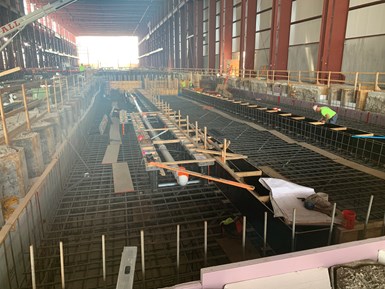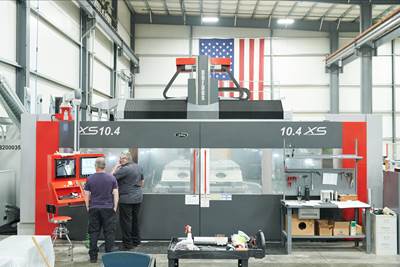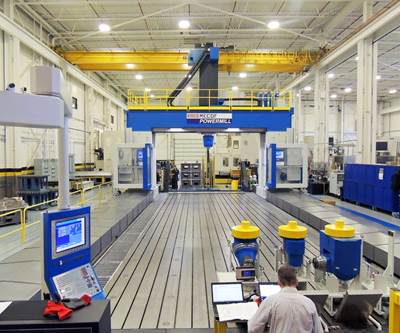Share



A massive rotary table for a Waldrich Coburg PowerTec bridge mill being hoisted aloft during transport. All photos courtesy of Waldrich Coburg.
There are surprisingly few fundamental differences between a large-format machine tool versus a typical job-shop machine tool. The end goal of a 164-foot-long Waldrich Coburg PowerTec bridge mill, for example, is the same as that of a traditional 10-foot VMC. It’s just that one of them is capable of machining nuclear waste containment vessels, and the other is not.
Is it just our American appetite for ALL-THINGS-BIG that fuels our fascination with giant machine tools? This article will argue that the answer is no — that there are other differences that we appreciate on an intuitive level, even if they are rarely talked about explicitly.
So let’s get explicit. Let’s dig into a fact of life for giant machine tool OEMs — a logistical skill set that is almost exclusive to them.
That skill set is transport, as in: How do you move a machine tool the size of a house from one location to another?
To answer that question, we turned to Waldrich Coburg, a company headquartered in Coburg, Germany, (but with expansive North American operations based in Erie, Pennsylvania) that has long been known for its manufacture of machine tools capable of producing the largest parts imaginable for the power, defense and construction industries.
Those swimming-pool-sized bucket shovels attached to 10-story hydraulic mining excavators? Waldrich Coburg machine tools produce parts like that.
“It's a niche market,” says Lee Gehrlein, VP of sales in North America. “It's not a commodity machine tool market. These are project machines that are typically customized around a very specific application.” Gehrlein says that, generally speaking, the business is composed of five segments: Newly built customized project machine tools; machine tool retrofitting; machine tool parts and service; specialty design spindles and spindle rebuilds; and finally what Gehrlein calls an “extensive history in machine tool relocation and reconfiguring.”

Waldrich Coburg employee Jim Thompson waves from atop a 10-meter rotary table on one of the company’s large (but not its largest) mill-turn machines.
Jason Grinarml, customer service manager, adds that the company’s North American operations include a full suite of personnel for administration, application engineering, project management, sales and specialists that handle spindle repair and full spindle rebuilds. Grinarml says that most, if not all, of these departments will be put to task during a typical relocation operation.
“Most of our most challenging transport situations don’t involve relocating a machine from an existing facility to a new one,” he says, “but are instead customers that bought a used piece of equipment.” It is not uncommon that these used machines — machines that are intended to last a lifetime — need to be retrofitted with new controllers or spindle units, then moved to a storage facility while the customer works on the foundation. (More on that in a minute.)
Step One: Disassembly
In most cases, Grinarml says, the existing customer — the seller of the machine tool — does not want the machine sitting around for six months while the purchaser constructs a new building or a new foundation. This means that the first job for Waldrich Coburg becomes disassembly and preparation for long-term storage. “Most of the time, before we remove the machine, we will do geometric checks on the equipment,” he says. “This is so we can certify that when we install the machine it will either meet or exceed those geometric conditions.”
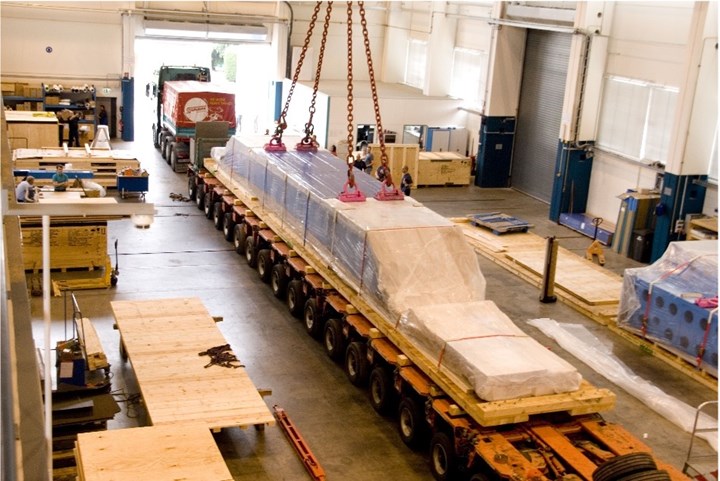
Custom shipping containers that contain machine tool components are loaded for transport. These machine tools can weigh in excess of 750,000 kilograms (1.65 million pounds), and those with large turntables result in over-width restrictions for travel on American highways.
Waldrich Coburg technicians arrive on site with 20-foot shipping containers that serve as mobile workshops. They contain all rigging equipment and measuring devices that will perform everything from laser positioning checks to geometric checks using large straight edges, as well as checks for planar alignments of heads and spindle C-axis conditions.
When these checks are complete, it is time to take the machine apart and prepare it for transport. “It’s quite the process,” Grinarml jokes.
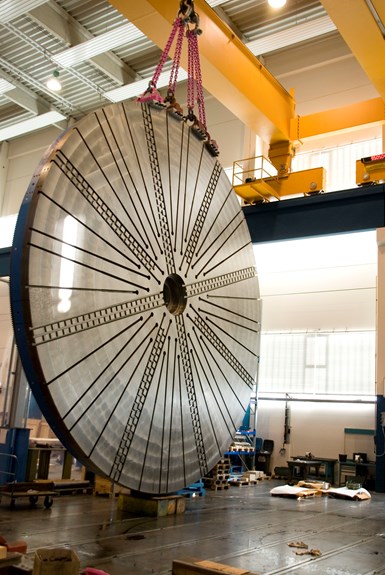
Waldrich Coburg installs specialized fixtures (seen here at the top, gripping the table) to help balance the weight. These fixtures must be shipped ahead of time to the customer.
It begins with a lead technician who will head up the entire disassembly, reassembly and installation process, and remain on site for the duration. Mechanical engineers and machine technicians disassemble the unit and begin the methodical process of moving its parts onto specially built pallets and into custom storage containers. In most cases, any customer that owns a Waldrich Coburg machine is prepared to handle large parts and can provide an overhead crane to lift the cross rails and other large components. Otherwise, the company brings its own mobile overhead cranes to assist.
As you might guess, lifting a large-format milling head and placing it onto a cross rail isn’t simply a matter of installing a couple of eye-bolts and hoisting it. The company installs specialized fixtures to not only help balance the weight, but also ensure that the guideways will be in the right orientation to match up to the crossrail. These fixtures must be shipped ahead of time to the customer.
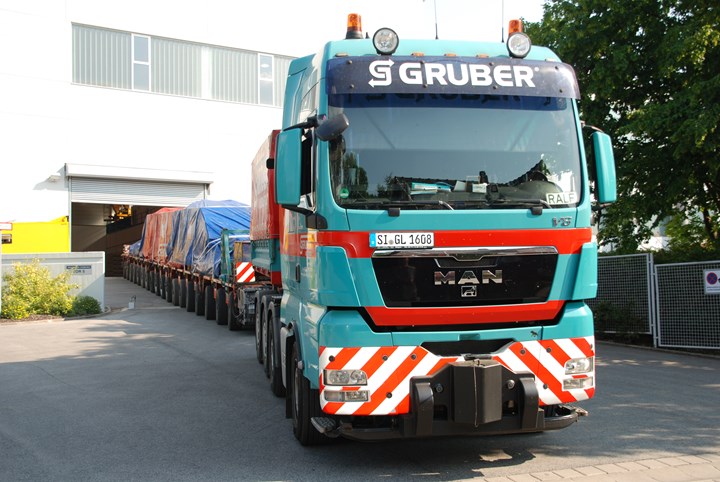
A shipping operation taking place out of the company’s headquarters in Coburg, Germany.
Step Two: Shipping
Once the machine tool is disassembled and ready to ship, an entirely new adventure begins. These machine tools can weigh up in excess of 750,000 kilograms — 1.65 million pounds — and those with large turntables result in over-width restrictions for travel on American highways.
Much like the situation with overhead cranes, many customers that own large-format machine tools already use their own logistics companies to arrange shipping. If not, Waldrich Coburg will make the arrangements. This typically means scheduling nighttime transportation to avoid road closures or weighing the option of shipping on barges rather than across solid ground.
At the end of shipping, we arrive at storage — an equally daunting logistical consideration. Since most companies have not prepared the necessary foundation for a large-format machine at the time of purchase, Waldrich Coburg provides the specs and blueprints that the purchasing company will take to an engineering company. This company will check soil conditions and determine how much concrete will be required to fill the pit. The answer to that question depends on what lies beneath the surface, which can be anything from bedrock (if you are lucky) to clay to loamy or sandy soil. In one case, the customer began digging its first trench and struck oil — not the “Eureka! Texas-tea!” variety but a contamination from a leak that had been saturating the ground for months or years. The customer had to pump the oil out of the ground until the EPA determined the site to be clean.
Typically before a large-format machine tool installation, an engineering company will check soil conditions and determine how much concrete will be required to fill the pit. The answer to that question depends on what lies beneath the surface.
In other cases, pilings will need to be driven into bedrock 30 feet below the surface before being filled with concrete. These are extreme examples, of course, but even typical circumstances often require long-term storage solutions that Waldrich Coburn will help resolve.
Step Three: Storage
The biggest hazard involved with long-term storage is rust. Prior to shipping, the machine tool components are wrapped and coated with a product called Cosmoline, a thick, waxy, oil-based material that hardens over time and inhibits corrosion. But as Lee Gehrlein points out, several variables can affect the success of those efforts against Mother Nature.
“We take every effort to wrap the equipment, package it, coat it and make sure that rust doesn't form over time,” he says. “But if you are storing the equipment outside, for example, or the logistics company poked a hole in the side of the packaging, that can present a problem.” Non-climate-controlled environments result in heating and cooling that allows the formation of condensation inside the machine, which is why every possible surface is coated with Cosmoline before storage.
Step Four: Installation
Once the customer’s foundation is complete and the machine is brought on site, installation is headed up by one of Waldrich Coburn’s lead technicians, who will remain to oversee the entire process. It is during this time that the 20-foot shipping containers that serve as mobile workshops are again put to use. These containers hold all of the rigging and measuring equipment required to ensure that the machine is installed precisely to Earth level.
The company’s machine technicians and application engineers begin by installing the cast iron components, followed by the installation of piping, chip conveyors and the enclosure. Finally, the company’s electrical engineers begin to rewire all components.
When everything is in place, a machine technician starts the machine, tests all functionality (including tool changers and head changers) and begins performing test cuts and probing cycles.
Step Five: Training
Now begins the final step of operator training, provided by a Waldrich Coburg applications engineer. During this process, the customer’s support is critical. “Having that customer’s support during this phase does a couple things,” Grinarml says. “It's saving them money on labor, but it's also getting their maintenance people familiar with this piece of equipment. And this is important because this machine will be expected to run consistently for the next 20 to 40 years. It also gives the customer experience directly from us on how the machine was actually built.”
By the time all is said and done, the entire process can last from one to three years, Gehrlein says. On the short end, a two-year installation might involve a company that only needs to move the machine tool from one location at their facility to another. At the other end of the spectrum is a greenfield situation where the customer is purchasing, shipping and installing a used piece of equipment in an entirely new location. This involves a justification phase, during which the customer considers all of the factors outlined in this article.
This initial justification phase is critical, Gehrlein says. “If they are looking at a used machine tool, they are asking several questions. What type of condition is it in? Can we reconfigure it to fit our needs? Can we retrofit it to current standards? What type of soil do we have? How much will the foundation cost? Because the machine tools that we're selling are designed to last 50 plus years. We recently had a machine tool that had been installed for 45 years that we just did a complete inspection and rebuilt the spindle unit, and it may well last another 50 years.”
“It’s that fact,” Grinarml jokes, “that presents a difficult situation as a sales guy.”
Related Content
4 Tips for Staying Profitable in the Face of Change
After more than 40 years in business, this shop has learned how to adapt to stay profitable.
Read MoreThe Future of High Feed Milling in Modern Manufacturing
Achieve higher metal removal rates and enhanced predictability with ISCAR’s advanced high-feed milling tools — optimized for today’s competitive global market.
Read MoreBallbar Testing Benefits Low-Volume Manufacturing
Thanks to ballbar testing with a Renishaw QC20-W, the Autodesk Technology Centers now have more confidence in their machine tools.
Read MoreAddressing Manufacturing Challenges with Automation
GrayMatter Robotics’ Physical AI robotic cells for manufacturing offer immediate impact and results.
Read MoreRead Next
The Culture Change of Large-Part Machining Automation
For Major Tool & Machine in its 75th anniversary year, confronting the skills gap involves a systemized approach focused on automation, and developing and retaining talent.
Read MoreIs That a CNC? Major Tool Edition
The cover of Modern Machine Shop’s November issue features a striking image: Three employees checking bore and thread sizes on a massive machined aluminum part — which is situated inside an even more massive five-axis machine tool. The caption reads, “Automation Still Needs You.” Curious about what you are seeing? Read on.
Read MoreMeet Colossus: An Inside Look at One of the Largest Five-Axis Machining Centers in the U.S.
My behind-the-scenes tour on the shop floor of Baker Industries began and ended with its Emco Mecof PowerMill, one of the biggest five-axis machining centers in the United States. The tour also shed light on the company’s highly aggressive approach to new equipment purchases.
Read More















